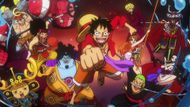When I discovered anime, I was fascinated to enter a medium filled with shows that became cultural phenomena. Where One Piece, Naruto, and Bleach are collectively known as the Big 3, these anime weren’t just successful; I believe they reshaped the landscape of global animation. As someone who grew up watching these series unfold over hundreds of episodes, I’ve come to realize that their legacy is more than just nostalgia.
The biggest reason these titles revolutionized anime is the sheer scale of their storytelling. Before them, many anime series were either short adaptations of manga or standalone original stories that wrapped up in one or two seasons.
While this format worked for a long time, there are some titles like Cowboy Bebop, Samurai Champloo, and Evangelion that have earned the title of being one of the classic series to watch.
The Big Three had bigger dreams. In my opinion, they gave us sagas, multi-arc journeys filled with hundreds of characters, intricate power systems, complex emotional arcs, and worldbuilding that could rival most fantasy epics.

What made a huge difference in the viewing experience these series provided was how deeply invested I became in not just the protagonists, but also the side characters, entire clans, crews, and even villains. Furthermore, One Piece takes a level ahead by being the most ambitious. Eiichiro Oda builds islands, cultures, political conflicts, and mythologies sometimes decades in advance.
Finally, there is Bleach, for its part, took a different route. It introduced layers upon layers of hidden factions and secret powers, and though it had pacing issues later in its run, the way Tite Kubo handled the Soul Society arc was brilliant. These anime series have ensured that the viewers need to watch them with undivided attention.
I don’t think enough people give credit to just how hard it is to make something this long and keep it consistent in tone, quality, and spirit. When we look at Western TV shows, many struggle to maintain their appeal even across a few seasons. Now imagine creating hundreds of episodes over multiple decades and still having viewers glued to their screens.
The biggest example that comes to mind is One Piece, with over 1000 episodes and still ongoing. This series proved that even during its weaker arcs, you could feel that Oda never lost sight of the grand vision. Each arc added a piece to the puzzle, and somehow, even filler episodes managed to add to the emotional landscape.
How these anime have created a blueprint for modern shonen

Looking at some of the series today, it’s impossible not to see the fingerprints of the Big 3. Modern hits like My Hero Academia, Jujutsu Kaisen, Black Clover, and Demon Slayer owe so much to the path they paved.
The structure of shonen anime training arcs, multi-phase villains, ensemble casts, ideological battles, and emotionally charged flashbacks was crystallized by Naruto, Luffy, and Ichigo’s journeys. Even the way modern anime uses music to amplify emotional scenes or drop cliffhangers at the end of episodes follows a rhythm established during the Big 3 era.
Moreover, the Big 3 proved that anime could be more than niche. They weren’t just Japanese cultural exports; they became global phenomena. They helped bridge the gap between East and West, turning anime from something ‘weird’ or ‘niche’ into a respected form of art and storytelling.
I remember seeing Naruto headbands at parties, hearing One Piece openings at conventions, and watching Bleach AMVs trend on YouTube. They created communities before social media fandoms became mainstream.
Final thoughts
Yes, I know the Big 3 aren’t flawless. They had filler arcs, pacing problems, and, in some cases, abrupt endings. But that’s what makes their impact even more impressive. Despite these flaws, they captivated millions for decades. They weren’t just series; they were milestones in our lives. They taught me patience, emotional depth, and what it means to follow a story all the way to the end.
